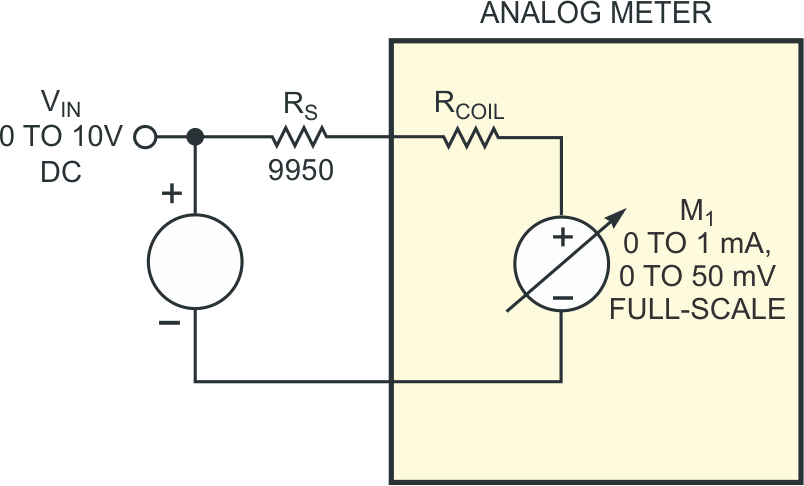Before shipping moving-coil meters, manufacturers may short-circuit the meters' terminals with a length of wire, which provides effective electromagnetic damping and results in better immunity to external mechanical vibration and shocks that can occur during transportation. This Design Idea applies essentially the same principle to analog meters under normal operating conditions. Connecting a meter to a voltage source with low internal resistance applies electromagnetic damping and makes the meter's readings more stable. Increased immunity to external vibration and shock takes on importance in mobile- or portable-system applications and especially in automotive devices.
 |
|
| Figure 1. | A typical analog moving-coil voltmeter employs a high-value series resistor, RS, to establish the full-scale range but doesn’t contribute to electromagnetic damping of the meter movement. |
For example, suppose that your application requires measurement of a 0 to 10 V power supply (Figure 1). You have available a typical electromechanical meter that presents a full-scale voltage rating, VFS, of 50 mV and a full-scale current rating of 1 mA. To obtain the 10 V full-scale voltage range, you add a series resistance, RS. First, calculate the meter's internal resistance, RCOIL:

Next, calculate the multiplier resistor, RS, as follows:

The resistance of RS typically greatly exceeds that of RCOIL and therefore significantly reduces the electromagnetic damping action on the meter movement. Although you can improve damping by shunting the meter with a capacitor, this approach also increases the meter's settling time.
Figure 2 illustrates a better approach, in which a moving-coil meter connects to the output of an operational amplifier, IC1, embedded in a deep negative-voltage-feedback loop. Because the op amp presents an extremely low equivalent output resistance, the meter's terminals are “virtually shorted,” providing effective electromechanical damping that results in more stable readings and increased shock and vibration resistance. In Figure 2, the resistive voltage divider comprising R1 and R2 connected to the op amp's noninverting input determines the meter's full-scale reading. You can add RF and CF to form an optional highpass filter to further improve the meter's settling time. Transistors Q1 and Q2 are also optional and added as overvoltage protection. Note that, for normal operation, the transistors' forward base-emitter voltage, VBE, should be several times larger than the meter's full-scale voltage, VFS, which is typically 50 to 100 mV.
A rail-to-rail-capable, single-supply micropower op amp makes a good choice for this application. If the input voltage, VIN, exceeds the op amp's minimum power-supply-voltage requirement, you can connect the op amp's VCC pin directly to the input terminal, as the dashed line in Figure 2 shows. In effect, the circuit combines the advantages of meter buffering and improved shock and vibration resistance with a traditional moving-coil meter's advantage of requiring no external power supply. You can choose from among many commercially available off-the-shelf, rail-to-rail output-micropower op amps that draw supply currents well below the full-scale current drain, IFS, of typical moving-coil meters. For example, Maxim's MAX4289 requires as little as 1 V and 9 µA of power, and the MAX4470 requires a minimum of 1.8 V but only 750 nA of supply current.
Although this Design Idea has so far related only to dc-voltage measurements, you can expand the circuit to include ac- and dc-voltage measurements (Figure 3). In this approach, you add a precision diodeless, full-wave-rectifier stage based on a single rail-to-rail operational amplifier and resistors R3, R4, and R5 (Reference 1). Resistors R1 and R2 determine the full-scale reading. This circuit requires an external dc power supply to drive op amps IC1 and IC2; voltage-limiting transistors Q1 and Q2 are optional.

